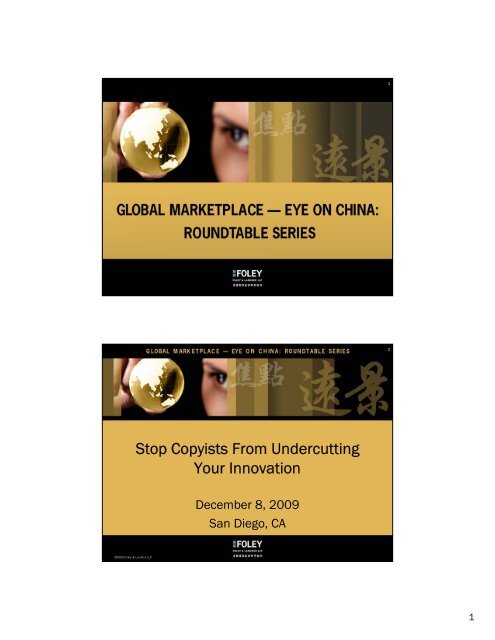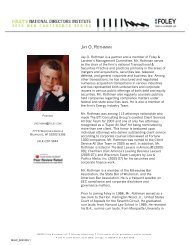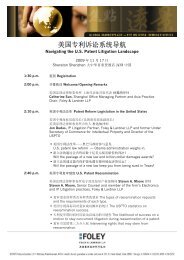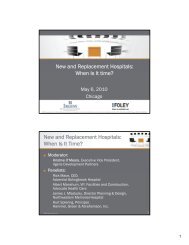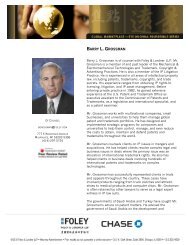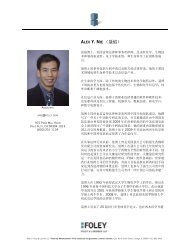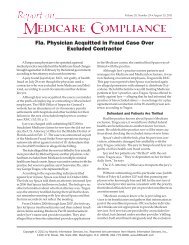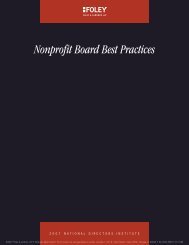Stop Copyists From Undercutting Your Innovation - Foley & Lardner ...
Stop Copyists From Undercutting Your Innovation - Foley & Lardner ...
Stop Copyists From Undercutting Your Innovation - Foley & Lardner ...
Create successful ePaper yourself
Turn your PDF publications into a flip-book with our unique Google optimized e-Paper software.
©2009 <strong>Foley</strong> & <strong>Lardner</strong> LLP<br />
©2009 <strong>Foley</strong> & <strong>Lardner</strong> LLP<br />
<strong>Stop</strong> <strong>Copyists</strong> <strong>From</strong> <strong>Undercutting</strong><br />
<strong>Your</strong> <strong>Innovation</strong><br />
December 8, 2009<br />
San Diego, CA<br />
1<br />
2<br />
1
Welcome<br />
Moderator<br />
– G. Peter Albert, Partner and Chair, San Diego/Del<br />
Mar Office IP Department, <strong>Foley</strong> & <strong>Lardner</strong> LLP<br />
Speakers<br />
– Kurt M. Kjelland, IP Partner, <strong>Foley</strong> & <strong>Lardner</strong> LLP<br />
– Alex Y. Nie, IP Associate, <strong>Foley</strong> & <strong>Lardner</strong> LLP<br />
– Xu Wen, President, Scihead Patent Agent Co., Ltd.<br />
©2009 <strong>Foley</strong> & <strong>Lardner</strong> LLP<br />
Discussion Topics<br />
Overview of The Third Amendment to China’s<br />
Patent Law<br />
– Kurt M. Kjelland, <strong>Foley</strong> & <strong>Lardner</strong> LLP<br />
Patent Enforcement in China<br />
– Alex Y. Nie, <strong>Foley</strong> & <strong>Lardner</strong> LLP<br />
New Trends of IP Protection in China<br />
– Xu Wen, President, Scihead Patent Agent Co., Ltd.<br />
©2009 <strong>Foley</strong> & <strong>Lardner</strong> LLP<br />
3<br />
4<br />
2
Overview of The Third Amendment<br />
to China’s Patent Law<br />
©2009 <strong>Foley</strong> & <strong>Lardner</strong> LLP<br />
Background &<br />
Legislative History<br />
©2009 <strong>Foley</strong> & <strong>Lardner</strong> LLP<br />
Kurt M. Kjelland<br />
<strong>Foley</strong> & <strong>Lardner</strong> LLP<br />
China’s Patent Law came into effect in 1985<br />
– Has been amended three times, each with a view<br />
to comply with international practice<br />
The First Amendment was enacted in 1992<br />
– Added pharmaceutical compositions to the list of<br />
patentable subject matter<br />
– Inaugurated China’s membership in the Patent<br />
Cooperation Treaty<br />
5<br />
6<br />
3
Background &<br />
Legislative History (cont.)<br />
The Second Amendment was enacted in 2000<br />
– Intended to make Patent Law compliant with the<br />
Trade-Related Aspects of Intellectual Property<br />
Rights Agreement (“TRIPS”)<br />
The Third Amendment was approved on<br />
December 27, 2008 and went into effect on<br />
October 1, 2009<br />
The Third Amendment was initiated as part of<br />
PRC national IP strategy<br />
©2009 <strong>Foley</strong> & <strong>Lardner</strong> LLP<br />
Background &<br />
Legislative History (cont.)<br />
Designed to promote innovations and<br />
implementation of patented technology<br />
– Changes to substantive requirements for patent<br />
grant<br />
– Included provisions for post-grant enforcement<br />
– Harmonized Chinese Patent Law to international<br />
norms<br />
©2009 <strong>Foley</strong> & <strong>Lardner</strong> LLP<br />
7<br />
8<br />
4
Third Amendment: Article 1<br />
“[T]his law is enacted in order to protect the<br />
legitimate rights of patentees, encourage<br />
invention-creations, promote the application<br />
of invention-creation, enhance innovative<br />
capacity and promote scientific progress and<br />
economic social development.”<br />
©2009 <strong>Foley</strong> & <strong>Lardner</strong> LLP<br />
Overview of Changes Enacted<br />
By The Third Amendment<br />
First filing in China: confidentiality review<br />
Changes to patentability standards: “absolute<br />
novelty”<br />
Patent Enforcement Considerations<br />
– Prior art defense codified<br />
– Patent infringement exemptions<br />
International patent exhaustion<br />
Regulatory exemption<br />
– Infringement damages: increased penalties available<br />
©2009 <strong>Foley</strong> & <strong>Lardner</strong> LLP<br />
9<br />
10<br />
5
Overview of Changes (cont.)<br />
Compulsory license issues<br />
Co-ownership<br />
Double patenting restricted<br />
Inventor remuneration required<br />
– Applicable to foreign enterprises<br />
– Policy or agreement can override<br />
Issues specific to certain types of patents<br />
– Disclosure rules for inventions relying on “genetic resources”<br />
– Changes relating to design patents<br />
©2009 <strong>Foley</strong> & <strong>Lardner</strong> LLP<br />
Foreign Filing/Confidentiality<br />
Review<br />
First filing requirement under the previous law<br />
– PRC Patent Law required that “any PRC entity or<br />
individual” must first file in China for its inventions<br />
made in China<br />
The Third Amendment replaces the first filing<br />
requirement with a confidentiality review system<br />
for an invention or utility model made in China<br />
– Content review required to prevent national security<br />
leaks<br />
– Similar to U.S. foreign filing license requirement<br />
©2009 <strong>Foley</strong> & <strong>Lardner</strong> LLP<br />
11<br />
12<br />
6
Foreign Filing/Confidentiality<br />
Review (cont.)<br />
Scope of requirement broadened to apply to<br />
anyone that made the invention in China<br />
– Impacts R&D activities sponsored by foreign entities<br />
in China<br />
Legal liability for failing to comply with the<br />
confidentiality review requirement prior to filing<br />
patent application outside of China<br />
– No patent right shall be granted in China<br />
– Divulging State secrets shall be given administrative<br />
sanction<br />
©2009 <strong>Foley</strong> & <strong>Lardner</strong> LLP<br />
Absolute Novelty Standard<br />
Previous law included a moderate novelty<br />
standard for assessing novelty<br />
– Considered publication anywhere in the world<br />
– Did not consider public use or knowledge outside<br />
China<br />
New patent law requires absolute novelty,<br />
removes territorial restrictions on prior art<br />
– Defines prior art as publicly known art anywhere in<br />
the world before the filing date<br />
– Applies to all categories of Chinese patents: invention<br />
patents, utility model patents, and design patents<br />
©2009 <strong>Foley</strong> & <strong>Lardner</strong> LLP<br />
13<br />
14<br />
7
Prior Art Defense Codified<br />
Statutory defense to infringement<br />
Infringement shall not be found if evidence exists<br />
proving that the accused infringing technology<br />
belongs to prior art<br />
Details provided in Supreme People’s Court’s<br />
draft Judicial Interpretation circulated in June<br />
2009<br />
– Single prior art shall be relied upon<br />
– Variations allowed under principle of doctrine of<br />
equivalence<br />
©2009 <strong>Foley</strong> & <strong>Lardner</strong> LLP<br />
International Patent<br />
Exhaustion<br />
Previous law provided only for domestic exhaustion,<br />
applied to products sold by the patentee in China<br />
New law provides for both domestic and<br />
international exhaustion of patent rights<br />
– Importation of any patented product or product directly<br />
obtained from the patented process, after the said product<br />
is sold by the patentee or by its licensed entity, shall not<br />
be deemed an infringement upon a patent right<br />
– No distinction between restricted and unrestricted sales,<br />
so unclear whether parties can contractually avoid<br />
international exhaustion<br />
©2009 <strong>Foley</strong> & <strong>Lardner</strong> LLP<br />
15<br />
16<br />
8
Regulatory Exemption For<br />
Infringement (Bolar Exemption)<br />
Producing, using or importing patented medicine or<br />
patented medicinal equipment for the purpose of<br />
providing the information as required for<br />
administrative examination and approval, and<br />
producing and importing the patented medicine or<br />
patented medicinal equipment exclusively for the<br />
said purpose, shall not be deemed an infringement<br />
upon a patent right<br />
Similar to Hatch-Waxman exemption under U.S. law<br />
©2009 <strong>Foley</strong> & <strong>Lardner</strong> LLP<br />
Damages<br />
Maximum statutory damages doubled to<br />
RMB 1 million (approximately $145K USD)<br />
The damages can also include the reasonable<br />
cost paid for stopping the infringement<br />
©2009 <strong>Foley</strong> & <strong>Lardner</strong> LLP<br />
17<br />
18<br />
9
Compulsory License<br />
Standard for compulsory license generally<br />
– Patent not implemented for 3 years after grant<br />
(and 4 years after filing); or<br />
– Patentee’s exercise of his patent right found to be<br />
an act restricting or eliminating competition<br />
(antitrust)<br />
Broader standard for pharmaceuticals<br />
– Exportation of drugs to foreign countries –<br />
implements the Doha Declaration<br />
©2009 <strong>Foley</strong> & <strong>Lardner</strong> LLP<br />
Compulsory License (cont.)<br />
– Extends to any public health purpose, not limited<br />
to “treatment of contagious diseases” as under<br />
prior law<br />
May require compulsory license for<br />
semiconductor technology if limited to use for<br />
public interest<br />
©2009 <strong>Foley</strong> & <strong>Lardner</strong> LLP<br />
19<br />
20<br />
10
Patent Co-Owners’ Rights<br />
For a co-owned patent case, an agreement with<br />
respect to exploitation of patent between/among the<br />
co-owners shall govern<br />
– Importance of joint development agreements heightened<br />
Where there is no agreement stated above, each<br />
co-owner may exploit the patent independently or<br />
grant a non-exclusive license to others provided that<br />
the license fee received shall be allocated<br />
between/among the co-owners<br />
But consensus from all co-owners is required for<br />
patent enforcement<br />
©2009 <strong>Foley</strong> & <strong>Lardner</strong> LLP<br />
Double Patenting<br />
Dual filing (utility model and invention) restricted<br />
– The same invention may only be granted one patent at any<br />
given time<br />
– Unclear whether restriction applies to obviousness-type<br />
double patenting or genus/species claims<br />
However, applicant may still file application for both a<br />
utility model and invention patent on the same day<br />
– Utility model patents are only subject to a formality<br />
examination, and typically issue earlier<br />
– Invention patent may later be granted if applicant declares<br />
intention to abandon previously granted utility model patent<br />
– Filing on different days will destroy novelty of later-filed<br />
application<br />
©2009 <strong>Foley</strong> & <strong>Lardner</strong> LLP<br />
21<br />
22<br />
11
Double Patenting<br />
Dual filing (utility model and invention)<br />
restricted<br />
– The same invention may only be granted one<br />
patent at any given time<br />
– Unclear whether restriction applies to<br />
obviousness-type double patenting or<br />
genus/species claims<br />
©2009 <strong>Foley</strong> & <strong>Lardner</strong> LLP<br />
Double Patenting (cont.)<br />
However, applicant may still file application<br />
for both a utility model and invention patent<br />
on the same day<br />
– Utility model patents are only subject to a<br />
formality examination, and typically issue earlier<br />
– Invention patent may later be granted if applicant<br />
declares intention to abandon previously granted<br />
utility model patent<br />
– Filing on different days will destroy novelty of<br />
later-filed application<br />
©2009 <strong>Foley</strong> & <strong>Lardner</strong> LLP<br />
23<br />
24<br />
12
Inventor Remuneration<br />
Invention and utility model: not less than 2% of<br />
the profits after the taxation earned from<br />
exploitation of the invention or Utility model<br />
Design: not less than 0.2% of the profits after the<br />
taxation earned from exploitation of the design<br />
If the entity licenses or transfers the patent, it<br />
must draw not less than 10% of the license fees<br />
or transfer fees after taxation and reward it to the<br />
inventor/creator as remuneration<br />
©2009 <strong>Foley</strong> & <strong>Lardner</strong> LLP<br />
Inventor Remuneration (cont.)<br />
Under the new draft Implementation Rules, such<br />
remuneration percentages are applicable to all<br />
entities, state-owned-enterprises or private<br />
companies, unless otherwise set forth in the<br />
company policy or individual contracts<br />
©2009 <strong>Foley</strong> & <strong>Lardner</strong> LLP<br />
25<br />
26<br />
13
Disclosure Rules for<br />
“Genetic Resources”<br />
Requires disclosure of the direct and original<br />
sources of genetic resources upon which an<br />
invention relies<br />
– Third Amendment does not define “reliance” or<br />
“genetic resources” and does not limit restriction to<br />
those in China only<br />
– Convention on Biological Diversity defines “genetic<br />
resources” to mean genetic material of actual or<br />
potential value, and “genetic material” means any<br />
material of plant, animal, microbial, or other origin<br />
containing functional units of heredity<br />
©2009 <strong>Foley</strong> & <strong>Lardner</strong> LLP<br />
Disclosure Rules for<br />
“Genetic Resources” (cont.)<br />
Invention not patentable if genetic resource<br />
obtained illegally<br />
– Patent applicant must prove that access was lawfully<br />
obtained<br />
– Unclear what constitutes illegal acquisition and use<br />
– Failure to comply could result in denial or invalidation<br />
of patent<br />
Until uncertainty is resolved, document and<br />
disclose that any genetic resource relied upon is<br />
subject to proper access<br />
©2009 <strong>Foley</strong> & <strong>Lardner</strong> LLP<br />
27<br />
28<br />
14
Design Patent Changes<br />
Heightened patentability standards<br />
– Same absolute novelty standard applies as for<br />
invention patents<br />
– “Non-obviousness” requirement<br />
Compared with the prior design or combination of the prior<br />
design features, the design for which a patent is granted<br />
shall have distinctive features<br />
Multiple designs now allowed in one application<br />
– Two or more similar designs for the same product<br />
An offer for sale now is an infringing act<br />
©2009 <strong>Foley</strong> & <strong>Lardner</strong> LLP<br />
Questions & Answers<br />
Kurt Kjelland<br />
Partner<br />
<strong>Foley</strong> & <strong>Lardner</strong> LLP<br />
11250 El Camino Real<br />
Suite 200<br />
San Diego, CA<br />
Phone: 858.847.6700<br />
Email: kkjelland@foley.com<br />
©2009 <strong>Foley</strong> & <strong>Lardner</strong> LLP<br />
29<br />
30<br />
15
©2009 <strong>Foley</strong> & <strong>Lardner</strong> LLP<br />
Patent Enforcement in China<br />
Alex Y. Nie, Esq.<br />
<strong>Foley</strong> & <strong>Lardner</strong> LLP<br />
Patent Enforcement in China is<br />
Important for US Companies<br />
Number of patent cases in trial courts:<br />
– 2006: 3186<br />
– 2007: 4028<br />
– 2008: 4074<br />
Number of IP cases involving a foreign entity<br />
– 2008: 70% more than in 2007<br />
– About 1/4 plaintiffs are US entities<br />
USTR’s 2009 Special 301 Report:<br />
– China as #1 in the Priority Watch List<br />
©2009 <strong>Foley</strong> & <strong>Lardner</strong> LLP<br />
31<br />
32<br />
16
The Dual-Track<br />
Enforcement System<br />
Judicial system<br />
– IP tribunals in over 70 intermediate trial courts, as<br />
well as provincial higher courts and the Supreme<br />
People’s Court<br />
– The Supreme People’s Court is considering to<br />
establish an Intellectual Property Appellate Court<br />
in Beijing<br />
©2009 <strong>Foley</strong> & <strong>Lardner</strong> LLP<br />
The Dual-Track<br />
Enforcement System (cont.)<br />
Administrative system<br />
– State Intellectual Property Office (SIPO) and its<br />
local branches<br />
– Can hear almost all kinds of patent-related<br />
disputes, e.g.:<br />
©2009 <strong>Foley</strong> & <strong>Lardner</strong> LLP<br />
Patent counterfeiting (passing off) – treble damages +<br />
criminal prosecution<br />
Compulsory licensing<br />
33<br />
34<br />
17
The Administrative Track<br />
Highly efficient and economic<br />
– More akin to mediation than adjudication<br />
– No complicated legal procedure such as discovery<br />
or cross-examination<br />
Highly qualified<br />
– SIPO is a newly established agency with a large<br />
number of employees better trained than many<br />
judges<br />
Decisions reviewable by courts<br />
©2009 <strong>Foley</strong> & <strong>Lardner</strong> LLP<br />
The Administrative Track<br />
The administrative agencies can not award<br />
damages<br />
The administrative agencies may lack<br />
effective means to enforce the decisions they<br />
render<br />
– In comparison, disputes over trademarks are<br />
heard by the State Administration for Industry and<br />
Commerce (SAIC) and its local branches, which<br />
have broad power over business activities of local<br />
companies<br />
©2009 <strong>Foley</strong> & <strong>Lardner</strong> LLP<br />
35<br />
36<br />
18
Damages<br />
Chint (China) v. Schneider Electric (France)<br />
– Schneider brought a patent infringement lawsuit<br />
against Chint, to force Chint into an acquisition<br />
deal; Chint sued Schneider for infringement of its<br />
own utility model patent<br />
– $47M awarded to Chint in Sept. 2007<br />
– The parties settled at $23M in April, 2009<br />
– Wenzhou Intermediate Court (Zhejiang Province)<br />
©2009 <strong>Foley</strong> & <strong>Lardner</strong> LLP<br />
Damages (cont.)<br />
Holley Communications (China) v. Samsung<br />
Electronics (Korea)<br />
– Holleycomm sued Samsung for patent<br />
infringement<br />
– SIPO held the patent valid<br />
– $7.4M awarded to Holleycomm in Dec, 2008<br />
– On appeal now<br />
– Hangzhou Intermediate Court (Zhejiang Province)<br />
©2009 <strong>Foley</strong> & <strong>Lardner</strong> LLP<br />
37<br />
38<br />
19
Chint – What do we learn?<br />
Chint v. Schneider and Holley v. Samsung illustrate a<br />
trend towards higher damages awarded by Chinese<br />
courts – finally to a level to effectively deter<br />
infringement?<br />
Importance of forum – what is special about<br />
Zhejiang province?<br />
Failure to take advantage of the “utility model”<br />
patent system<br />
– In 2008, of the 226,000 utility model applications<br />
filed, < 1% were filed by foreign entities<br />
– Yet, these utility patents may well be enforceable<br />
©2009 <strong>Foley</strong> & <strong>Lardner</strong> LLP<br />
Chint - China’s IP Wisdom?<br />
In 1999<br />
– Hitachi, Panasonic, Mitsubishi, Time-Warner, Toshiba<br />
and JVC (6C) issued a statement alleging that various<br />
Chinese DVD player manufactories infringed about<br />
2,000 patents owned by 6C. Chinese DVD<br />
manufacturers, without assessment of the merit of<br />
the allegation, agreed to pay $4 royalty per player.<br />
– Then other foreign companies followed, as of 2006,<br />
Chinese DVD manufacturers pay about $20 royalty for<br />
each player, which equals about $12.5B profit within<br />
5 years.<br />
©2009 <strong>Foley</strong> & <strong>Lardner</strong> LLP<br />
39<br />
40<br />
20
Chint - China’s IP Wisdom?<br />
(cont.)<br />
In 2009<br />
– China’s top 10 home appliance (TV) manufacturers<br />
retained <strong>Foley</strong> & <strong>Lardner</strong> and Scihead as preferred<br />
legal service providers to represent them in<br />
international and domestic IP matters.<br />
©2009 <strong>Foley</strong> & <strong>Lardner</strong> LLP<br />
Damages<br />
Medium damage awarded is ~15% of the IP<br />
owner’s damage claim 1<br />
Damage claims made by IP owners are already<br />
low compared to the US and compared to the<br />
degree of harm caused 1<br />
Statutory damages that can be awarded by a<br />
court has been increased from 500K RMB to 1M<br />
RMB (~$146K)<br />
1 “Intellectual Property Rights Protection in China: Trends in Litigation and Economic Damages,” NERA,<br />
http://www.nera.com/Publication.asp?p_ID=3693 Last accessed Oct 6, 2009<br />
©2009 <strong>Foley</strong> & <strong>Lardner</strong> LLP<br />
41<br />
42<br />
21
Judicial Interpretations<br />
Several Provisions of the Supreme People’s<br />
Court on Issues Concerning Applicable Laws<br />
to the Trial of Patent Infringement<br />
Controversies (“Judicial Interpretation”), draft<br />
published in June, 2009<br />
– Doctrine of equivalents, claim construction, and<br />
Prosecution history estoppel<br />
– All elements rule (vs. redundant element rule)<br />
– Prior art defense<br />
©2009 <strong>Foley</strong> & <strong>Lardner</strong> LLP<br />
Judicial Interpretations (cont.)<br />
– Declaratory judgment<br />
– For more information, see:<br />
Zhao, Nie and Tang, “PRC Supreme People’s<br />
Court Patent Infringement Enforcement Guidance:<br />
The “Draft” Published for Comments by the Patent<br />
Community,” accessible at:<br />
http://www.foley.com/publications/pub_detail.aspx?pubid=6159<br />
©2009 <strong>Foley</strong> & <strong>Lardner</strong> LLP<br />
43<br />
44<br />
22
Doctrine of Equivalents, Claim<br />
Construction and Estoppel<br />
Dongfang Machine Core Factory v. Jinling<br />
Hardware Ltd. Co.<br />
– One of the “Top 100 IP cases” in China, named by<br />
the Supreme Court<br />
– Chinese invention patent, 92102458.4, directed<br />
to apparatus and methods for cutting metal plates<br />
for making music boxes<br />
©2009 <strong>Foley</strong> & <strong>Lardner</strong> LLP<br />
Doctrine of Equivalents, Claim<br />
Construction and Estoppel<br />
– The specification: an advantage of the invention is<br />
that component 7 is attached to a thick fastening<br />
component 5 so that it does not vibrate even<br />
slightly while being cut by the rotating blade 2<br />
– In the alleged infringing device, component 7<br />
hangs in the air, and there is no fastening<br />
component 5<br />
©2009 <strong>Foley</strong> & <strong>Lardner</strong> LLP<br />
45<br />
46<br />
23
Dongfang v. Jinling (cont.)<br />
Trial court: no infringement<br />
– The fastening component 5 is missing from the<br />
alleged infringing device<br />
– Did not consider doctrine of equivalents (DOE)<br />
Higher court: no infringement<br />
– DOE is not satisfied<br />
– Specification estopped the patentee from<br />
broadening the claims<br />
©2009 <strong>Foley</strong> & <strong>Lardner</strong> LLP<br />
Dongfang v. Jinling (cont.)<br />
Supreme Court: reversed<br />
– DOE is satisfied – if “basically the same” with<br />
respect to means, functions and goals<br />
– DOE is satisfied even if the alleged infringing<br />
product is inferior to the patented<br />
– The Court made note of the defendant’s<br />
inequitable conduct, but did not state whether it<br />
was a factor of consideration<br />
©2009 <strong>Foley</strong> & <strong>Lardner</strong> LLP<br />
47<br />
48<br />
24
Dongfang v. Jinling (cont.)<br />
The Judicial Interpretations will likely clarify<br />
the law with respect to DOE<br />
– DOE requires “substantially identical” means,<br />
functions and goals<br />
©2009 <strong>Foley</strong> & <strong>Lardner</strong> LLP<br />
Looking Forward<br />
Transparency<br />
– Courts in relatively developed areas, e.g., Beijing,<br />
Shanghai, Jiangsu, and Zhejiang, publish decisions on<br />
the website<br />
Political pressure (good or bad?)<br />
– Pfizer’s Viagra patent litigation in China ended with an<br />
encouraging success for foreign patent holders<br />
To watch:<br />
– Eli Lilly & Co.’s v. Gan & Lee Pharmaceuticals (China)<br />
– Patents related to Humalog were invalidated, now on<br />
appeal<br />
©2009 <strong>Foley</strong> & <strong>Lardner</strong> LLP<br />
49<br />
50<br />
25
Questions and Answers<br />
Alex Nie<br />
Associate<br />
Registered Patent Agent<br />
<strong>Foley</strong> & <strong>Lardner</strong> LLP<br />
11250 El Camino Real<br />
Suite 200<br />
San Diego, CA<br />
Phone: 858.847.6700<br />
Email: anie@foley.com<br />
©2009 <strong>Foley</strong> & <strong>Lardner</strong> LLP<br />
©2009 <strong>Foley</strong> & <strong>Lardner</strong> LLP<br />
捍卫智慧 没有硝烟的战场<br />
Defending Intelligence - A Battle Ground<br />
Without Gunpowder<br />
中国大陆知识产权保护现状简介<br />
An Introduction to IP Protection in China<br />
广州三环专利代理有限公司/北京三环知识产权代理有限公司董事长<br />
Scihead Patent Agent Co., Ltd<br />
温旭 教授、律师<br />
Professor Xu Wen, Attorney/President<br />
December 8, 2009<br />
www.scihead.com<br />
51<br />
52<br />
26
一、 中国大陆专利商标代理机构及专利商标申请简况<br />
1. Patent & trademark agencies and applications in China<br />
(一)全国共有专利代理机构722家,数量排在前10位的省市依次为:北京<br />
196,广东69,上海59,辽宁42,浙江42,江苏41,山东25,湖南23,四川<br />
20,湖北19,共计536家,占全国专利代理机构的74.2% 。<br />
(1) There are 722 patent agencies in mainland China, 536<br />
(about 74.2%) of which are in the top 10 areas including<br />
Beijing(196), Guangdong(69), Shanghai(59), Liaoning(42),<br />
Zhejiang(42), Jiangsu(41), Shandong(25),<br />
Hunan(23),Sichuan(20), and Hubei(19).<br />
www.scihead.com<br />
©2009 <strong>Foley</strong> & <strong>Lardner</strong> LLP<br />
一、 中国大陆专利商标代理机构及专利商标申请简况<br />
1. Patent & trademark agencies and applications in China<br />
(二)全国共有商标代理机构4703家,数量排在前10位的省市依次为:北<br />
京1019,广东985,浙江395,江苏319,上海303,山东257,福建<br />
155,四川130,辽宁103,重庆100,共计3766家,占全国商标代理机<br />
构的80.1%。<br />
(2) There are 4,703 trademark agencies in mainland China,<br />
3,766 (about 80.1%) of which are in the top 10 areas<br />
including Beijing(1,019), Guangdong(985), Zhejiang(395),<br />
Jiangsu(319), Shanghai(303), Shandong(257), Fujian(155),<br />
Sichuan(130), Liaoning(103), and Chongqing(100).<br />
www.scihead.com<br />
©2009 <strong>Foley</strong> & <strong>Lardner</strong> LLP<br />
53<br />
54<br />
53<br />
54<br />
27
一、 中国大陆专利商标代理机构及专利商标申请简况<br />
1. Patent & trademark agencies and applications in China<br />
(三)全国共有14051家律师事务所,从业人数约15万人,其中数量排在前十位的<br />
依次是:广东1192,北京1083,上海845,江苏750,山东696,浙江592,湖南<br />
577,辽宁555,四川551,河南539,共计7378家,占全国律师事务所的<br />
52.5%,但从业人数却约占70%以上,因为人数规模较大的律师事务所都集中<br />
在北京、广东、上海等前十位的省市。<br />
(3) There are 14,051 law firms in mainland China with<br />
about 150,000 people in practice. Top 10 areas with the<br />
most law firms are Guangdong(1,192), Beijing(10,83),<br />
Shanghai(845), Jiangsu(750), Shandong(696),<br />
Zhejiang(592), Hunan(577), Liaoning(555), Sichuan(551),<br />
and Henan(539) which altogether have 7,378 law firms,<br />
(about 52.5% of total) and employ about 70% of all people<br />
in practice.<br />
www.scihead.com<br />
©2009 <strong>Foley</strong> & <strong>Lardner</strong> LLP<br />
一、 中国大陆专利商标代理机构及专利商标申请简况<br />
1. Patent & trademark agencies and applications in China<br />
(四)1985年4月至2009年7月全国共申请专利4457062件,数量排在前<br />
十位的依次为:广东696488件,江苏507157件,浙江448731件,山东<br />
332898件,上海322370件,北京298580件,辽宁192163件,四川<br />
145359件,湖北129608件,河南114940件,共计3198294件,占全<br />
国总申请量的71.8%。<br />
(4) <strong>From</strong> Apr. 1985 to Jul. 2009 4,457,062 patent<br />
applications were filed. Top 10 areas are<br />
Guangdong(696,488), Jiangsu(507,157),<br />
Zhejiang(448,731), Shandong(332,898),<br />
Shanghai(322,370), Beijing(298,580), Liaoning(192,163),<br />
Sichuan(145,359), Hubei(129,608), Henan(114,940),<br />
totaling 3,198,294 filings (about 71.8% of total).<br />
www.scihead.com<br />
©2009 <strong>Foley</strong> & <strong>Lardner</strong> LLP<br />
55<br />
56<br />
55<br />
56<br />
28
一、 中国大陆专利商标代理机构及专利商标申请简况<br />
1. Patent & trademark agencies and applications in China<br />
(五)自1979年我国恢复全国商标统一注册以来,我国的商标注册年申请量<br />
从1980年的2.6万件迅猛增长到2008年的69.8万件(其中受理国外申请<br />
为10.8万件),国内商标申请排名前5位省(市)分别为广东省105541件、<br />
浙江省79063件、北京市51855件、江苏省38014件和上海市35540件,<br />
共计310013件,占国内总申请量的52.5%。<br />
(5) In 2008, there were 698,000 trademark applications,<br />
significantly higher than 26,000 applications in 1980. Top 5<br />
areas were Guangdong(105,541), Zhejiang(79,063),<br />
Beijing(51,855), Jiangsu(38,014), Shanghai(35,540) with<br />
310,013 applications (about 52.5% of total).<br />
www.scihead.com<br />
©2009 <strong>Foley</strong> & <strong>Lardner</strong> LLP<br />
一、 中国大陆专利商标代理机构及专利商标申请简况<br />
1. Patent & trademark agencies and applications in China<br />
专利商标申请及专利商标代理机构较集中分布在:<br />
Patent & Trademark application filings and agencies are<br />
concentrated in:<br />
珠三角的广东Guangdong Province of the Pearl River Delta;<br />
长三角的江浙沪Jiangsu, Zhejiang, Shanghai of the Yangtse River<br />
Delta;<br />
北京市Beijing<br />
中国知识产权的大三角; The Great IP Delta of China;<br />
三环知识产权的大三环 The Great Three-ring of Scihead IP.<br />
www.scihead.com<br />
©2009 <strong>Foley</strong> & <strong>Lardner</strong> LLP<br />
57<br />
58<br />
57<br />
58<br />
29
二、 中国大陆知识产权服务机构的组成特点<br />
2. The characteristics of IP agencies in mainland China<br />
了解中国知识产权服务机构的组成特点,有助于外国事务所选择最佳<br />
最合适的合作伙伴。随着2009年中国涉外专利申请业务的全面开放,<br />
全国专利商标所经历了一次较大的调整与变化,目前代理机构共有如<br />
下几种模式:<br />
An understanding of the characteristics of IP agencies in<br />
China helps overseas IP firms choose best suited business<br />
partners. Typically there are three types of IP agencies in<br />
China.<br />
www.scihead.com<br />
©2009 <strong>Foley</strong> & <strong>Lardner</strong> LLP<br />
二、 中国大陆知识产权服务机构的组成特点<br />
2. The characteristics of IP agencies in mainland China<br />
(一)以港专、贸促会、柳沈、上海所、永新所等为代表的大约10家老招牌最早从事涉外知识<br />
产权代理机构涉外经验较丰富,手中的国外客户资源多,翻译人才多,但面临的问题是<br />
国内案源很少,人才流失严重,收费较高;<br />
业务比较单一,重点在于翻译工作,又懂专利,又懂技术,又有律师执照的人较少,随着<br />
特权的消失,竞争力已今非昔比。<br />
(1) Old brand in bound IP agencies represented by 10 earliest<br />
agencies such as CPA, CCPIT, Liu-Shen, SPTL, NTD, etc:<br />
Experienced in handling in bound cases, specialized in servicing<br />
in bound foreign applications and translation, high service fees;<br />
lack of domestic cases, loss of talents.<br />
Simplified business, focused on translation, shortage of patent<br />
attorneys with technological qualifications, losing edges in<br />
competition.<br />
www.scihead.com<br />
©2009 <strong>Foley</strong> & <strong>Lardner</strong> LLP<br />
59<br />
60<br />
59<br />
60<br />
30
二、 中国大陆知识产权服务机构的组成特点<br />
2. The characteristics of IP agencies in mainland China<br />
(二)以三友、三环、集佳、康信等为代表的大约10家中生代的涉外事务所:<br />
大多数是在2000年左右<br />
100人以上规模的事务所<br />
竞争力较强,业务保持平稳,甚至有较大发展<br />
三环所的优势<br />
(2) The new vital force of in bound IP firms represented by 10 firms<br />
including Sanyou, Scihead, Unitalen, Kangxin, etc:<br />
Started in around 2000;<br />
More than 100 staff;<br />
Competitive, stable business, progressing quickly;<br />
Advantages of Scihead<br />
www.scihead.com<br />
©2009 <strong>Foley</strong> & <strong>Lardner</strong> LLP<br />
二、 中国大陆知识产权服务机构的组成特点<br />
2. The characteristics of IP agencies in mainland China<br />
(三)以金杜、大成、华诚等律师所为代表的具有专利代理资质的律师所:<br />
具有专利资质<br />
实际上从事专利申请的人数、代理专利申请的业务量很有限,主要从事<br />
知识产权诉讼业务,相对来讲不够专业。<br />
(3) Law firms with patent agent service qualifications,<br />
represented by King & Wood, Dacheng, Huacheng:<br />
Qualified for patent agent service;<br />
Limited staff and experience in patent prosecution,<br />
technologically not competitive, focus on IP litigations.<br />
www.scihead.com<br />
©2009 <strong>Foley</strong> & <strong>Lardner</strong> LLP<br />
61<br />
62<br />
61<br />
62<br />
31
二、 中国大陆知识产权服务机构的组成特点<br />
2. The characteristics of IP agencies in mainland China<br />
建议合作的伙伴应该考虑选择一些中等规模以上,专利、商标、诉讼业<br />
务较全面的,并且有中国客户案源与之交换业务的代理机构,作为合作<br />
伙伴,这些代理机构的收费也较合理,通常比老牌所低20%左右,而且<br />
实际代理水平并不亚于老牌所,有些方面还优于其。<br />
Suggestions for choosing business partners in China:<br />
Agencies should be of medium size, comprehensive service<br />
in patent, trademark and litigation aspects, having lots of<br />
domestic cases for exchange. Such agencies charge 20%<br />
less than old brand agencies, and they offer high quality<br />
and provide even better service in some aspects.<br />
www.scihead.com<br />
©2009 <strong>Foley</strong> & <strong>Lardner</strong> LLP<br />
三、 中国大陆的一些专利资助政策<br />
3. Financial incentives for patent filings in mainland China<br />
中国由“中国自造”到“中国制造”再到“中国创造”的改革演变过程中,专利的<br />
数量逐年增加,专利的含金量逐年提升,对外专利商标申请或PCT申请量每<br />
年也在增多,华为2008年以1737项PCT申请成为全球第一,标志着中国在若<br />
干年后涉外专利申请将有大幅度的提升。了解中国大陆的专利激励政策,有<br />
助于结合中国国情,拓展中国的专利业务。<br />
The number of patent applications increases year by year,<br />
including foreign-related patent applications or PCT applications.<br />
Take Huawei as an example, in 2008,Shenzhen Huawei<br />
Technology Co.,Ltd.,was ranked No. 1 in the number of PCT<br />
applications filed (1737), overtaking Japan's Panasonic and<br />
Philip.<br />
Inventor/Creator remuneration and reward encourage the<br />
development of IP business in China.<br />
www.scihead.com<br />
©2009 <strong>Foley</strong> & <strong>Lardner</strong> LLP<br />
63<br />
64<br />
63<br />
64<br />
32
三、 中国大陆的一些专利资助政策<br />
3. Financial incentives for patent filings in mainland China<br />
(一)高新技术企业认定,须有一项发明或六项实用新型专利,占30分,满分<br />
为100分,缺少专利分不能认定为国家高新技术企业,被认定为高新技<br />
术企业可减税10%。<br />
(1) In China, for a company to be certified as a high-tech<br />
enterprise, there is a patent requirement which accounts for<br />
30% of the overall evaluation: the company must have one<br />
invention or six utility model patents. Without this 30% patent<br />
aspect, application for high-tech enterprise can’t be<br />
approved. A high-tech enterprise can enjoy 10% reduction on<br />
Enterprise Income Tax.<br />
www.scihead.com<br />
©2009 <strong>Foley</strong> & <strong>Lardner</strong> LLP<br />
三、 中国大陆的一些专利资助政策<br />
3. Financial incentives for patent filings in mainland China<br />
(二)国内专利申请普遍给予资助,实用新型专利资助500—2000元不等,<br />
发明专利资助1000—6000元不等,有的分为申请和授权两个阶段分别<br />
给予资助。国外申请的资助奖励10000—100000元不等。<br />
(2) Inventor/Creator remuneration and reward:<br />
Utility model —— RMB500~2,000<br />
Invention —— RMB1,000~6,000<br />
Foreign filings:<br />
RMB10,000 —— 100,000<br />
www.scihead.com<br />
©2009 <strong>Foley</strong> & <strong>Lardner</strong> LLP<br />
65<br />
66<br />
65<br />
66<br />
33
三、 中国大陆的一些专利资助政策<br />
3. Financial incentives for patent filings in mainland China<br />
(三)对优秀的专利授予省或国家的专利金奖或优秀奖,最高奖金可达300<br />
万元。<br />
(3) Golden patent prizes or outstanding patent prizes are<br />
granted for high quality patents by the state or provincial<br />
government, up to RMB3,000,000.<br />
www.scihead.com<br />
©2009 <strong>Foley</strong> & <strong>Lardner</strong> LLP<br />
三、 中国大陆的一些专利资助政策<br />
3. Financial incentives for patent filings in mainland China<br />
诸如此类的奖励措施对企业的专利申请有较大的促进作用。国外的事务所应当<br />
注意到国内的动态,拓展业务要结合中国国情,切不可完全照搬美国及西方的<br />
一套,尤其在收费方式及标准上应有所变通,英国有一个所就采取定额打包方<br />
式收费,获得了不少中国客户。<br />
Such encouraging policies greatly promote the patent<br />
applications of the enterprises. Foreign law firms should pay<br />
attention to these IP trends in China and take China’s<br />
situation and circumstances into consideration while<br />
developing business in China.<br />
Foreign law firms should be flexible in fee schedule, instead of<br />
copying the same standard rate from their own countries. For<br />
example, a British law firm attracts many Chinese clients by<br />
providing a fixed package fee rather than charging by hourly<br />
rate.<br />
www.scihead.com<br />
©2009 <strong>Foley</strong> & <strong>Lardner</strong> LLP<br />
67<br />
68<br />
67<br />
68<br />
34
三、 中国大陆的一些专利资助政策<br />
3. Financial incentives for patent filings in mainland China<br />
不少国外的所,为了减低成本,拓展中国业务,通常采取中国申请国外<br />
的专利的基础性工作尽量由中国的所完成,程序和核心部分由美国或<br />
其他国家的所完成,反过来由外国进入中国的业务也尽量由中国所去<br />
做,这样收费的标准可以降下来。<br />
In order to reduce the cost when expanding business in<br />
China, many foreign law firms often choose local Chinese<br />
agents to do the basic work for Chinese companies’ foreign<br />
patent application, or foreign companies’ operation<br />
entering the China market. Foreign law firms only handle<br />
the core issues and oversee the entire procedure.<br />
www.scihead.com<br />
©2009 <strong>Foley</strong> & <strong>Lardner</strong> LLP<br />
四、中国的专利、商标法律修改情况<br />
4. Revision of patent law and trademark law in China<br />
(一)中国的商标法草案正在修改之中,其中最大的修改是取消异议程序,<br />
加快审批速度。<br />
(1) The most obvious revision of the 3 rd draft of Chinese<br />
Trademark Law is to cancel the trademark opposition<br />
procedure in order to accelerate the application.<br />
www.scihead.com<br />
©2009 <strong>Foley</strong> & <strong>Lardner</strong> LLP<br />
69<br />
70<br />
69<br />
70<br />
35
四、中国的专利、商标法律修改情况<br />
4. Revision of patent law and trademark law in China<br />
(二)中国修改后的专利法已于2009年10月1日正式实施,主要修改为:<br />
1.相对新颖性修改为绝对新颖性<br />
——拓宽了现有技术范围,提高了专利授权标准<br />
2.外观设计授权标准引入抵触申请规定<br />
——提高了外观专利授权标准<br />
(2) The third amendment to Chinese patent law has come into force<br />
on<br />
Oct. 1 st , 2009. The main revisions are:<br />
A) Adoption of absolute novelty — heightened patentability<br />
standard<br />
Adoption of Interference procedure in design patent — raising<br />
B) patentability standards for design patent<br />
www.scihead.com<br />
©2009 <strong>Foley</strong> & <strong>Lardner</strong> LLP<br />
四、中国的专利、商标法律修改情况<br />
4. Revision of patent law and trademark law in China<br />
3.增加了外观设计许诺销售侵权内容<br />
——扩大了专利侵权的范围<br />
4.提高酌定侵权赔偿额, 将制止侵权的合理支出纳入赔偿范围<br />
——加大惩罚专利侵权的力度<br />
C) To add that an offer for sale in relation to design patent is an<br />
infringing act, enabling patentees to pursue claims of<br />
infringement at trade fairs or wholesale markets<br />
— broaden the scope of the patent infringement<br />
D) Increased statutory damages and reasonable expenses incurred<br />
by the patentee to stop infringement that having been in<br />
existence in regulations<br />
— heavy penalty for patent infringement<br />
www.scihead.com<br />
©2009 <strong>Foley</strong> & <strong>Lardner</strong> LLP<br />
71<br />
72<br />
71<br />
72<br />
36
五、专利无效与侵权诉讼的成功案例<br />
5. IP Cases<br />
(一)“索尼”诉“步步高”DVD外观专利侵权案<br />
成功要点:抢回诉权, 击中要害<br />
(1) “Sony” vs “BBK” DVD design patent infringement case<br />
(二)“晶艺”诉“深圳机场”、“白云机场”、“西安机场”专利侵权案<br />
成功要点:经营使用,构成侵权<br />
(2) “KGE” vs “Shenzhen airport”, “Baiyun airport”, “Xi’an<br />
airport” patent infringement case<br />
www.scihead.com<br />
©2009 <strong>Foley</strong> & <strong>Lardner</strong> LLP<br />
五、专利无效与侵权诉讼的成功案例<br />
5. IP Cases<br />
(三) 组合眼镜发明专利是否具有创造性无效案<br />
成功要点 :反向思维,有论有据<br />
(3) The patent invalidation case focused on the creativity of<br />
patent<br />
(四)“无锡电池”与“深圳电池”专利侵权与无效案<br />
成功要点:重点突破,全面突围<br />
(4) The patent infringement and invalidation case concerning<br />
battery<br />
www.scihead.com<br />
©2009 <strong>Foley</strong> & <strong>Lardner</strong> LLP<br />
73<br />
74<br />
73<br />
74<br />
37
五、专利无效与侵权诉讼的成功案例<br />
5. IP Cases<br />
(五)北京某博士诉广州某博士“博士论文”侵权案<br />
成功要点:证据反用,巧破死结<br />
(5) The copyright infringement case concerning a PH.D.<br />
dissertation<br />
(六)“佛山日丰”与“上海日丰”商标侵权之诉<br />
成功要点:企业名称,突出使用<br />
(6) The trademark infringement case concerning “Rifeng” hose<br />
www.scihead.com<br />
©2009 <strong>Foley</strong> & <strong>Lardner</strong> LLP<br />
五、专利无效与侵权诉讼的成功案例<br />
5. IP Cases<br />
(七)广州星群与广东星群企业名称之诉<br />
成功要点:曾经合作,具有恶意<br />
(7) The litigation concerning “Xingqun” trade name<br />
(八)“诸葛酿”与“诸葛亮”酒谁是谁非<br />
成功要点:在先权利,依法保护<br />
(8) “Zhugeliang” vs “Zhugeniang” the trademark case<br />
concerning wine<br />
www.scihead.com<br />
©2009 <strong>Foley</strong> & <strong>Lardner</strong> LLP<br />
75<br />
76<br />
75<br />
76<br />
38
五、专利无效与侵权诉讼的成功案例<br />
5. IP Cases<br />
(九)“广州立白”购买“重庆奥妮”商标独占许可纠纷案<br />
成功要点:未曾备案,合同存假<br />
(9) The trademark dispute concerning exclusive license<br />
(十)“香港荣华”与 “苏氏荣华”荣华品牌争夺战<br />
成功要点:诚实信用, 皇帝条款<br />
(10) The mooncake brand battle between “HK Ronghua” and<br />
“Shunde Ronghua”<br />
www.scihead.com<br />
©2009 <strong>Foley</strong> & <strong>Lardner</strong> LLP<br />
五、专利无效与侵权诉讼的成功案例<br />
5. IP Cases<br />
(十一)“西门子”与“深圳合信”专利侵权纠纷案<br />
(11) “Simens”vs “Co-trust” patent infringement case<br />
www.scihead.com<br />
©2009 <strong>Foley</strong> & <strong>Lardner</strong> LLP<br />
77<br />
78<br />
77<br />
78<br />
39
谢谢!Thanks!<br />
www.scihead.com<br />
©2009 <strong>Foley</strong> & <strong>Lardner</strong> LLP<br />
温旭 Xu Wen<br />
广州三环专利代理有限公司、<br />
北京三环知识产权代理有限公司 董事长、总经理<br />
President<br />
Scihead Patent Agent Co., Ltd ;<br />
Beijing Scihead Intellectual Property Agent Co., Ltd<br />
Tel: +86-20-37616191<br />
Mob: +86-13902206386<br />
E-mail: wenxu@scihead.com<br />
79<br />
79<br />
40


